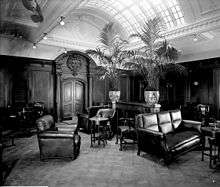Bedford Lemere
Bedford Lemere & Co was a firm of British architectural photographers active in the late nineteenth and early twentieth century.
History

The company was established by Bedford Lemere (born 1839, died 1911) in 1861, with its studio at 147 Strand, London from 1867 to 1947. His son Henry (also known as Harry) Bedford Lemere (born 1865, died 1944) joined the firm in 1881 and was one of the best known photographers, and the principal person behind the firm in its heyday.[1]
Bedford Lemere & Co. was the leading English firm of architectural photographers between 1870 and 1930, and pioneered the photography of new buildings. Their images captured the use of new technologies such as the motor car, electric light and motion pictures and the introduction of the steel frame and reinforced concrete which revolutionised architecture.[2]
Bedford Lemere & Co's client list was wide-ranging; they worked for anyone that needed architectural photography: property companies, estate agents, decorators, businesses needing photographs of their premises or house-owners who wanted photographs of their homes. Bedford Lemere & Co photographed buildings by notable architects; John Norton (architect), Matthew Digby Wyatt, Ernest George, Ernest George, Harold Peto, Arthur Blomfield, Alfred Waterhouse and Edward Blakeway I'Anson who designed Winterfold House in Surrey.
The firm was also particularly well known for photographs of cruise ship interiors, customers including Canadian Pacific Line, Cunard Line, Orient Lines, Peninsular and Oriental Steam Navigation Company, Union-Castle Line and White Star Line; many of these are now in the collection of the National Maritime Museum in London.
The firm also had premises in Manchester between 1875 and 1877, and kept a strong presence in the North West and Scotland for 40 years. This included working with Gillow’s of Lancaster and S J Waring & Sons of Liverpool, and the subsequent Waring & Gillow firm of furnishers and decorators, established in 1897 following their merger. Bedford Lemere went on to photograph the Waring & Gillow’s munitions factories during the First World War.
Henry Bedford Lemere received the Hood medal from the Royal Photographic Society in 1941.
After closing the studio at 147 Strand in 1947, the firm moved to 3 Park Lane, Croydon. It was acquired by Archie Handford Ltd in 1967.
Works
The majority of Bedford Lemere & Co's surviving photographs are cared for by Historic England in its public archive. Over a quarter of the firm’s output, estimated at 100,000 images, is held by Historic England in its public archive in Swindon. The collection is by far the most important surviving collection of its work. This includes 21,800 large-format glass negatives, and around 3,000 prints. The collection also includes some albums and day books, which give a unique insight into the company’s activities
Over 24,000 images can be seen online, free of charge.[3] Small caches of Bedford Lemere & Co’s photographs are held elsewhere including at the Royal Institute of British Architects, the V&A, the National Maritime Museum and the Royal Commission on the Ancient and Historical Monuments of Scotland.
Publications
- Nicholas Cooper, The Opulent Eye: Late Victorian and Edwardian Taste in Interior Design, ISBN 0-8230-7402-1
- Nicholas Cooper, The Photography of Bedford Lemere & Co, ISBN 978-1-84802-061-0
References
- ↑ Bedford Lemere photographs retrieved 6 March 2011
- ↑ Nicholas Cooper, The Photography of Bedford Lemere & Co, ISBN 978-1-84802-061-0
- ↑ http://www.englishheritagearchives.org.uk/results/resultsaj.aspx?t=Quick&cr=bedford+lemere+&+CO&io=True&l=all